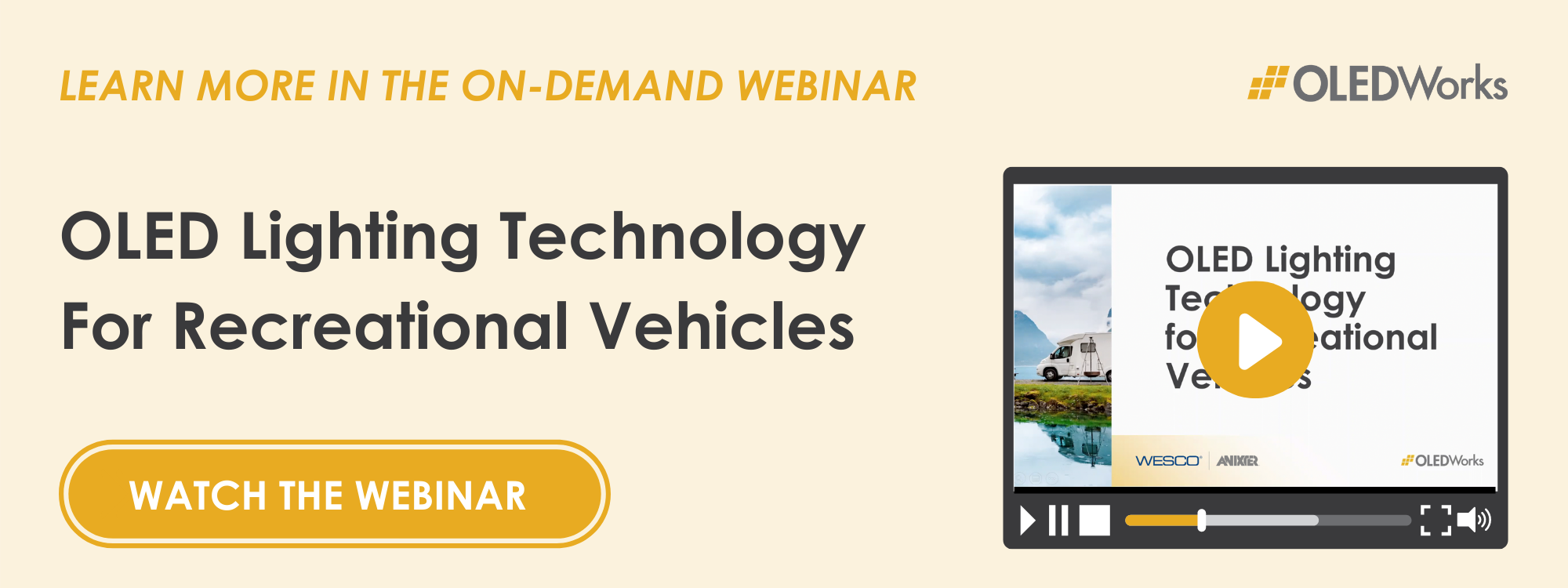![[On-Demand Webinar] OLED Lighting Technology for Recreational Vehicles](https://www.oledworks.com/wp-content/uploads/2021/06/RV-Webinar-Header-750x254.png)
By Dr. Kathleen Vaeth, Director of OLED User Experience (UX)
Recently, I presented a webinar on OLED Lighting Technology for Recreational Vehicles in collaboration with WESCO International. Throughout the webinar, I explained why OLED lighting is an ideal light source for the modern RV owner, and therefore, a light source that should be considered for integration in your next RV design.
There are three key aspects of OLED lighting technology that are particularly beneficial for use in recreational vehicles.
-
-
- Low heat generating properties of OLEDs give designers creative freedom to integrate the panels on or in any material in the RV.
- OLED lighting panels produce naturally glare-free illumination making it one of the most comfortable lighting solutions for small spaces.
- With their ultra-thin and lightweight profiles, OLED lighting panels can be integrated into confined spaces without adding bulk.
-
Low Heat Provides Design Freedom
OLED panels are surface area emitters, which means that the minimal heat they generate is spread across the entire surface of the panel. This means that they do not feel hot when operating, which allows them to be safely integrated into wood, leather, or even fabric, expanding RV design possibilities.
While other lighting can make a confined space feel hot and stuffy, OLED lighting’s cool-to-the-touch operation provides bright illumination that create a comfortable environment.
Glare-free OLEDs are Comfortable Lighting Solutions
Made of layers of organic materials, OLED lighting emits light evenly from the whole surface of the panel. This creates a highly uniform (greater than 90%) Lambertian emission, which prevents harsh shadows, is glare-free, and easy on the eyes. Combined with the fact that OLED lighting has no UV and has been rated exempt from all blue light risk to your eyes and skin, OLEDs are a healthy and comfortable light source that is ideal for the smaller interior of RVs where people spend their time relaxing.
Thin, Lightweight OLEDs Don’t Add Bulk
The organic layers of an OLED panel are as thin as a human hair, and sit atop a thin glass substrate, making the entire panel less than 2mm thin. As naturally surface area emitters, they don’t need bulky components like diffusors or heat sinks which require additional space for the installation. This enables increased design flexibility in the integration of lighting throughout the vehicle, saving space where it is at a premium. In fact, thin and lightweight OLED panels can be integrated easily onto vertical surfaces, further expanding design options past traditional lighting placements. That, combined with the fact that OLEDs can have a mirror finish in the off state, allows for lighting fixtures that integrate seamlessly into the interior, blending into the background when not on.
Watch the full webinar to learn more about the exciting design advantages that OLED lighting can offer RV manufacturers or reach out to an OLEDWorks engineer to discuss your RV lighting projects and ideas.



